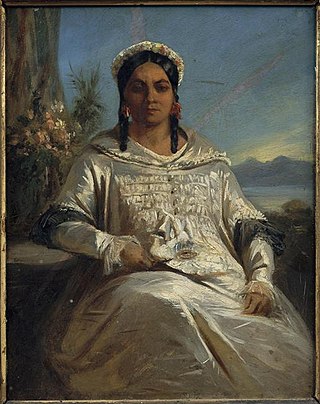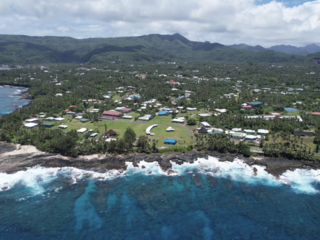
The Samoan Islands were first settled some 3,500 years ago as part of the Austronesian expansion. Both Samoa's early history and its more recent history are strongly connected to the histories of Tonga and Fiji, nearby islands with which Samoa has long had genealogical links as well as shared cultural traditions.

Politics of Samoa takes place in a framework of a parliamentary representative democratic state whereby the Prime Minister of Samoa is the head of government. Existing alongside the country's Western-styled political system is the fa'amatai chiefly system of socio-political governance and organisation, central to understanding Samoa's political system.

The Samoan Islands are an archipelago covering 3,030 km2 (1,170 sq mi) in the central South Pacific, forming part of Polynesia and of the wider region of Oceania. Administratively, the archipelago comprises all of the Independent State of Samoa and most of American Samoa. The land masses of the two Samoan jurisdictions are separated by 64 km (40 mi) of ocean at their closest points.

Pōmare IV, more properly ʻAimata Pōmare IV Vahine-o-Punuateraʻitua, was the Queen of Tahiti between 1827 and 1877. She was the fourth monarch of the Kingdom of Tahiti.

Taʻū is the largest inhabited island in the Manuʻa Islands and the easternmost volcanic island of the Samoan Islands. Taʻū is part of American Samoa. In the early 19th century, the island was sometimes called Opoun.

The Manuʻa Islands, or the Manuʻa tele, in the Samoan Islands, consists of three main islands: Taʻū, Ofu and Olosega. The latter two are separated only by the shallow, 137-meter-wide Āsaga Strait, and are now connected by a bridge over the strait. The islands are located some 110 kilometers east of Tutuila and are a part of American Samoa, an unincorporated territory of the United States. Their combined area is 56 square kilometers, and they have a total population of 1,400. Taʻu is the largest of these islands, with an area of 44 km2 (17 sq mi), and it has the highest point of the Manuʻa, at 931 meters. Politically, the islands form the Manuʻa District, one of the three administrative divisions of American Samoa.

The London Missionary Society was an interdenominational evangelical missionary society formed in England in 1795 at the instigation of Welsh Congregationalist minister Edward Williams. It was largely Reformed in outlook, with Congregational missions in Oceania, Africa, and the Americas, although there were also Presbyterians, Methodists, Baptists, and various other Protestants involved. It now forms part of the Council for World Mission.

The Tuʻi Tonga Empire, or Tongan Empire, are descriptions sometimes given to Tongan expansionism and projected hegemony in Oceania which began around 950 CE, reaching its peak during the period 1200–1500.

Tui Manuʻa Elisara was the last Tui Manu'a titleholder in Manu'a, which is now part of the U.S. Territory of American Samoa. Elisala was the son of Tui Manuʻa Alalamua whose genealogy descended from the Sa Tagaloa.

Ātua is an ancient political district of Samoa, consisting of most of the eastern section of Upolu and the island Tutuila. Within Samoa's traditional polity, Ātua is ruled by the Tui Ātua together with the group of six senior orators of Lufilufi and 13 senior matai from throughout Ātua, comprising the Fale Ātua. The fono (meeting) of Atua's rulers takes place in Lufilufi on the great malae of Lalogafu'afu'a.

The islands of Samoa were originally inhabited by humans as early as 1000 BC. After being invaded by European explorers in the 18th century, by the 20th and 21st century, the islands were incorporated into Samoa and American Samoa.

Benjamin Franklin Tilley was an American Naval officer who served from the end of the American Civil War through the Spanish–American War. He was the first acting governor of American Samoa as well as the territory's first naval governor.

The title Tui Manuʻa was the title of the ruler or paramount chief of the Manuʻa Islands in present-day American Samoa.

Matāʻafa is one of the four paramount tama-a-ʻaiga titles of Samoa. It is one of two such titles originating from the Atua district at the east end of Upolu island and has its historical seat in the village of Amaile. Prominent holders of the title include Matā'afa Iosefo of Falefa, one of the three rival candidates for the kingship of Samoa during the early colonial period, Matāʻafa Faumuina Fiame Mulinuʻu I of Lepea and Lotofaga, who became leader of Samoa's pro-independence Mau movement after Tupua Tamasese Lealofi III's assassination; and his son Fiame Matāʻafa Faumuina Mulinuʻu II (1921–1975), the first Prime Minister of Samoa.
Edward Stanley Kellogg was a United States Navy Captain who served as the governor of American Samoa. Kellogg graduated from the United States Naval Academy in 1892 and joined the Naval Engineer Corps. He served as an assistant engineer on numerous ships and participated in the Spanish–American War. He retired in 1920, and became governor three years later, making him only one of two Naval Governors of American Samoa to hold the office following retirement from the service. As Governor, Kellogg asserted the authority of the United States over the tribal chiefs of the islands. He removed the title of Tu'i Manu'a from Chris Young, claiming it implied king-like authority over the people of American Samoa. He also removed Chief Tui Manu'a from power, resulting in widespread protest among the islands' people. Kellogg died at the National Naval Medical Center in Maryland and was buried at Arlington National Cemetery.
The Tui Manu'a Graves Monument is a funerary marker and grave site on the island Ta'u, the largest island of the Manu'a group in American Samoa. It is located northwest of the junction of Ta'u Village and Ta'u Island Roads on the west side of the island. It consists of a stone platform, about 3 feet (0.91 m) in height, that is roughly rectangular in shape with a projection at one end. Three graves are marked by square sections of smoothed stones, while a fourth is marked by a marble column. A possible fifth grave, unmarked, is in the projection. It is the burial site of several tu'i, or kings, of Manu'a, including Tui Manu'a Matelita and Tui Manu'a Elisala, the Samoan leader whose signature granted the United States hegemony over the islands.

Vailoatai is a village in southwestern Tutuila, the main island of American Samoa. It is located on the eastern end of Leone Bay. The village is known for its beautiful malae, nested along the island's rugged southern coast and lined by the fale tali mālō of its village chiefs.
Taliutafa Christopher Leiesilika Young, also known as Christopher Taliutafa Young, Chris Young or Kilisi Young was the last claimant to the traditional title Tui Manu'a of Manu'a, a group of islands in the eastern part of the Samoan Islands. He was deposed from this title and exiled by American Governor Edward Stanley Kellogg because the idea of monarchy was incompatible with the Constitution of the United States.
Lumā is a village on the northwest coast of Taʻū Island in American Samoa, south of the village of Taʻū and north of Siʻufaga. The last Tui Manuʻa is buried in Lumā. It is also where anthropologist Margaret Mead researched and authored her classic Coming of Age in Samoa in 1925. Lumā and neighboring Siʻufaga are subvillages of the Village of Taʻū.

The annexation of the Leeward Islands or the Leewards War was a series of diplomatic and armed conflicts between the French Third Republic and the native kingdoms of Raiatea-Tahaa, Huahine and Bora Bora, which resulted in the conquest of the Leeward Islands, in the South Pacific archipelago of the Society Islands in modern-day French Polynesia.


















